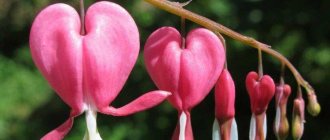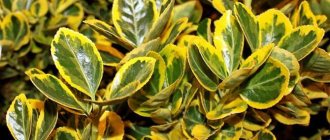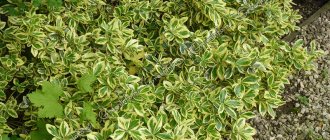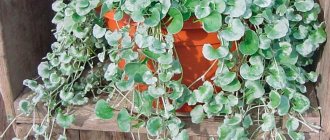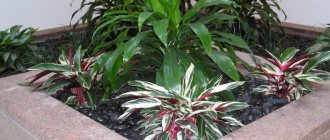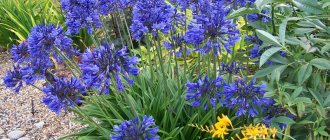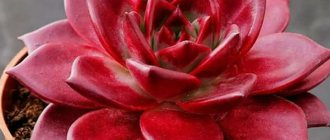The topic of the article is euonymus in landscape design. Let's talk about what this ornamental plant is, what types and types it comes in, how to plant it correctly and care for it. Let's start with the fact that in the fall almost all plants fade, except evergreens. In this regard, the euonymus, on the contrary, reveals itself as never before. And it pleases with its appearance before the snow falls or, in general, all year round.
Euonymus in autumn - bright red color Source o-flora.com
It should be noted that this plant is widespread on almost all continents. But each region has its own, so to speak, local species, which is strikingly different from others. All varieties of euonymus have one very surprising thing in common - the decorative content of this plant is not flowers, but leaves. This is a variety of colors and shapes that are preserved even in the most severe frosts. The color palette ranges from traditional green to variegated colors.
The most amazing thing is that in autumn the foliage becomes multi-colored. What kind of shades are not found here? The euonymus also contains a seed capsule. Many people confuse it with flowers, but they are not. The box opens in the form of a flower, and inside there are quite large seeds. In this case, the box is painted in different shades like flowers. This is why euonymus is so popular among landscape designers.
general information
Among hundreds of species there are evergreen and deciduous. There are completely dwarf creeping varieties, and there are tall giants. Most of them are heat-loving, but some are still able to withstand severe frosts.
The tallest and most spreading trees stretch up to 10 m. Most often, bushes up to 3-5 cm in diameter are found, and species up to 1.5-2 m are considered miniature. Creeping varieties are classified separately. By the way, they are good for green hedges and arches.
Euonymus is a flowering plant that blooms towards the end of spring. Its buds are not very noticeable, unlike the colorful leaves, which by autumn collect all shades from yellow to purple. In addition, long earrings, which also gradually change shade, look unusual. Keep in mind that euonymus is a poisonous plant.
Photo: sadogorod25.ru
Preparing for winter
The climate of the temperate zone allows the euonymus to withstand frosts down to −20 ° C, but provided that it is insulated with snow and polyethylene. If frosts in winter exceed −30 °C, then you should not risk the southern bush. It is necessary to transplant the shrub with an earthen lump into a box and bring it into the home for wintering, which may not be heated. The main thing is that the plant does not remain unprotected in the cold.
Note! Snow, straw, spruce branches, dry grass and other materials that create an air cushion can serve as ground cover material for preserving the root system.
Thus, Japanese euonymus is a wonderful plant that amazes with its unusual greenery. It will look impressive on any site. The main thing is to plant it correctly and provide decent care.
Types of euonymus
In our latitudes, only two species are common - European and warty. But we will tell you about a few more quite popular ones!
European euonymus
There are two main subspecies of this euonymus - shrubby and tree-like. The tree, depending on the conditions of the region, can grow up to 8 m. Frost resistance is average.
Photo: pinterest.com
Warty euonymus
A medium-sized shrub up to 1.5 m is notable for its very slow growth and high frost resistance. Despite its not very romantic name, it is surprisingly decorative. The shoots become overgrown with characteristic thickenings.
Photo: stroyremned.ru
Broadleaf euonymus
This is a tall shrub up to 5 m with abundant flowering and a pungent aroma. But this species is more often grown for medicinal purposes. Therefore, it is not so in demand among gardeners and landscape designers.
Photo: flower.onego.ru
Euonymus Fortune
And again frost-resistant, and also very decorative. This is a very compact Chinese euonymus in the form of a variegated creeping shrub up to 50 cm.
Photo: ozon.ru
Great-winged euonymus
A tall tree-like shrub grows well in the shade. But still, in sunny areas it is much more beautiful, and is grown mainly in the form of single plantings.
Photo: stroyremned.ru
Japanese euonymus
A heat-loving species that does not tolerate temperatures below +5 degrees. But the good news is that it winters well indoors or in a covered greenhouse. Therefore, it is mainly grown in tubs.
Photo: vivaiocipolloni.it
Dwarf euonymus
It is easily distinguished by its atypical narrow lanceolate leaves with curved tips. It grows up to 1 m in height, but quickly expands in width and covers entire areas.
Photo: sadik.tomsk.ru
Celosia (60 photos): types, planting and proper care
Use in landscape design
The most popular type of euonymus used in landscape design is the winged one. Dwarf is not inferior in its aesthetic value.
In landscape design, shrubs are used for:
- decoration of a stone or alpine slide;
- hedges;
- curb.
The plant is great for creating various compositions for every taste. It can exist as a backdrop for colorful flowers and other perennials. The openwork crown will give the composition airiness and lightness.
Euonymus care
Euonymus has rather banal and restrained requirements. A little moderation in everything - and it will grow well and delight you with its beauty!
Temperature
The ideal summer temperature for euonymus is about 20 degrees. For indoor flowerpots in winter it needs to be lowered to 6-12 degrees so that the plant gains strength by spring.
Photo: distano.ru
Lighting
The light should be bright, but diffused, because aggressive direct rays can leave burns and affect the color of the leaves. Light requirements may vary between varieties.
Photo: idoom.ru
Watering
In summer, you will definitely need abundant watering and regular spraying, because dry soil and dry air are the first causes of leaf loss. But in winter, euonymus hardly needs additional moisture at all.
Photo: pinterest.com
The soil
Any soil is suitable, but it must be light and loose. It is good to use leaf soil with turf and organic matter, and also add peat and sand.
Photo: dimgou.ru
Fertilizers and fertilizing
Euonymus reacts sensitively to feeding. Moreover, in this case, you can safely alternate mineral complexes and organic matter with an interval of 1-2 weeks.
Photo: olalastudio.ru
Trimming
The bush is pruned for decorative purposes to create a neat and well-groomed crown. In addition, for branching in the spring, fresh shoots must be pinched.
Photo: cemicvet.mediasole.ru
Wintering
This applies to outdoor plants that will remain directly in the garden. Winter-hardy species do not require additional care and tolerate even -25 degrees in the snow. If the branches are partially frozen, they will recover over the season.
Photo: speakingflower.ru
Transfer
And this point applies to indoor and potted plants. Decorative euonymus gradually depletes the soil, so it is recommended that even mature, slow-growing bushes be replanted once every 2-3 years.
Photo: idoom.ru
Lilies of the valley (50 photos): types, planting and proper care
Nothing but good
In addition to its unique decorative properties, the plant has other equally valuable qualities. For example, its wood and bark are used in the national economy: for the production of gutta-percha, staple fabrics, artificial silk ; soaps, oils. Previously, spindles were made from wood, so the second name for euonymus is spindle tree.
Euonymus fruits and leaves are widely used in folk medicine. This is an excellent remedy for hypertension, treatment of cardiovascular diseases, various types of fungal diseases, and is used as a laxative and hemostatic agent.
Healing recipes for healing tinctures
They can be prepared at home. Try to follow all the recommendations and, most importantly, do not forget - prevention of the disease is better than any treatment. And herbal tinctures are primarily designed to prevent diseases. So, some recipes:
- For nervous disorders: prepare flowering branches of euonymus, finely chop and brew one tablespoon of raw material with one glass of boiling water. Hold the mixture over a water bath for 20 minutes, then let it brew for at least 10 minutes, then strain and pour into a dark bottle. Take 1 tablespoon three times a day before meals.
- If the skin is damaged by fungal diseases, the following recipe is recommended: grind the dry leaves and fruits of the euonymus. Brew one teaspoon of the mixture with a glass of boiling water, leave in a water bath for 15 minutes with the lid closed. Leave for 45 minutes, strain. Wipe the affected areas with the resulting decoction, then apply a compress soaked in euonymus infusion.
- To treat hypertension, tincture of euonymus bark is used. Pour one tablespoon of crushed bark into 200 grams of medical alcohol. Leave for 7 days in a dark place, shaking occasionally. Strain. Use as a homeopathic remedy 10 to 15 drops 3 times a day before meals, for stage 1 and 2 hypertension.
Attention! The plant is poisonous, treat with caution. In case of poisoning, rinse the stomach with water and a 1% solution of potassium permanganate. Drinking plenty of water and milk is recommended.
Wonderful neighbor
Euonymus will not only decorate the garden with beautiful and light foliage. Euonymus hedges tolerate pruning well, so they always have a neat and elegant appearance. Dwarf and herbaceous varieties have proven themselves well as ground cover plants that retain moisture in the ground. In addition, shrubs can be used on slopes as plants that strengthen the soil.
Young branches are used for weaving household utensils: baskets, tueskas, trays. The cake can be added to pet food. Fruits infused with vinegar are used in the treatment of skin diseases in animals.
Plant a spreading, spherical bush of European euonymus solo, and it will decorate the garden not only with its original shape, but also with a magnificent play of color from early spring to late autumn.
Reproduction and planting of euonymus
Colored and variegated varieties are propagated only vegetatively in order to preserve their characteristics. Garden plants are easiest to propagate by layering. Just bend the low shoots to the ground in a groove, secure with staples, dig in, leaving only the top, and wait. Once the roots appear, they can be separated and replanted.
Cuttings are a universal method for both potted and outdoor plants. At the beginning of summer, cut apical cuttings of about 7 cm with an internode, treat them with a stimulant and root them in peat with sand under a film. They can be transplanted in 2 months.
At the beginning of the season, root children with roots about 30 cm long can be separated from the main plant. They are simply immediately transplanted to a permanent place. And dwarf species with abundant root shoots can be propagated completely painlessly by dividing the rhizomes.
Photo: idoom.ru
Top dressing
In principle, additional feeding is not required . However, it would not be amiss to feed the plant with complex mineral fertilizers in the spring and summer. This is not required more than once a month.
Which fertilizers should be used depends on the activity of the plant. The dwarf Japanese euonymus is known to have two growth waves . The fact that the growth period is over is indicated by the appearance of buds (cones) at the top of each shoot.
And vice versa, when these buds begin to open and new leaves are formed, another wave of shrub growth is expected.
So, at the moment when activity is just beginning, you should feed the plant with nitrogen fertilizers. In the middle of the period, you can use complex fertilizers , and at the moment when the buds are formed - phosphorus-potassium fertilizers .
Pest and disease control
Spider mites, mealybugs and codling moths are especially dangerous. Less commonly, red mites, scale insects and moths settle on trees. All of them spoil and destroy leaves, but complex insecticides help against all of them.
Drying of branches and necrosis of the bark most often occurs due to a fungal infection. The second most common fungus is ascochyta blight, as a result of which the leaves become covered with brown spots that gradually lighten. You need to get rid of the affected parts of the plant, and then treat everything with Bordeaux mixture.
Photo: fb.ru
Yasnotka (60 photos): types, planting and proper care
Trimming
Euonymus lends itself perfectly to molding; they can be given any desired shape. They endure the procedure painlessly. Sanitary pruning is mandatory for them. Old shoots must be replaced with new ones in order to extend not only the life of the plant, but also to maintain their visual appeal. It is necessary to wear gloves when working with the bush because of the poisonous sap of the plant!
When molding the crown of the euonymus, it should be taken into account that due to the slow growth, it will not be possible to correct the mistake made soon.
Euonymus – photo
The euonymus is so spectacular that it is impossible to deny yourself the pleasure of admiring it. So don't refuse!
Photo: it.wow-plants.com
Photo: prorastet.ru
Photo: vsevdom.net
Photo: domashniecvety.ru
Photo: pinterest.ru
Photo: mykaleidoscope.ru
Photo: spb.tiu.ru
Photo: en.wikipedia.org
Photo: domashniecvety.ru
Photo: gazon7777.ru
Photo: stroy-podskazka.ru
Photo: ogorodnik24.ru
Photo: my-farmer.ru
Photo: jalita.com
Photo: alleyann.ru
Photo: energysad.ru
Photo: e-semena.ru
Photo: stylishgarden.ru
Photo: idoom.ru
Photo: alexbego.ru
Photo: regionoperator.ru
Photo: princely-garden.ru
Photo: ceneo.pl
Did you like the post? Subscribe to our channel in Yandex.Zen, it really helps us in our development!
Botanical description of the plant
The photo and description of the shrub under the general name euonymus sometimes contain contradictory data, but these are not mistakes of the authors, but a confusion of species characteristics, made under the influence of the misconception that all plants under this name certainly have similar characteristics.
In reality, plants called euonymus (popularly known as wolf's bast, blind hen, goatweed or sourweed) may include the following characteristics:
- vine, shrub or small tree;
- woody plant, deciduous or evergreen;
- a shrub with round or tetrahedral shoots;
- flowers are pale green or slightly brownish;
- inflorescences in the form of a corymb or brush;
- fruit winged or with thorns;
- seeds are red, black, brown, covered with an apimentum;
- This four-part capsule can, when ripe, acquire beautiful shades of yellow, purple, red or pink in different species.
Even in the characteristic features by which researchers distinguished genera and species, discrepancies can easily be found in nature. There are species with 4 or 5 sepals, consisting of petals, stamens, a pistil with 3 or 5 lobes, a capsule, which is said to usually consist of 4 sections. But there are certain species in which this rule is not observed.
.
